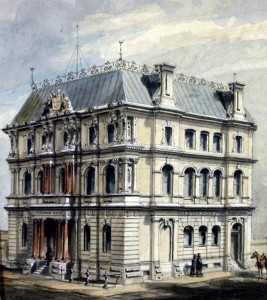Chapter 9. Economic Transformation and Continuity, 1818-1860s
9.8 Economic and Social Change

Building the canals required two things of critical importance to the economic, social, and political history of Upper and Lower Canada: money and a workforce.
Banks and Locks
First, banks were required because all that debt had to reside somewhere. An agency was needed to both store the growing amounts of capital in the colonies and to act as a lender to entrepreneurs and governments. These early banks also coined the local currency. The Bank of Montreal appeared first, in 1817, followed by the Bank of Quebec and the Bank of Canada (also in Montreal), and then the Bank of Upper Canada. All were chartered in the years between 1819 and 1822, and other banks would be established — a flurry of them in the 1830s — though not all lasted more than a few years. The Bank of Upper Canada held a monopoly position in the colony for nearly a generation, and it was very much an instrument of the Family Compact: the Bank’s directorship was dominated by members of the colony’s executive council.[1]
The interests of the bank were thus indistinguishable from those of the political elite in the colony and the colonial elite was very interested in canals. The bank’s inaugural president, William Allan, was also an active investor in and a director of the Welland Canal Company. Allan was not alone in this regard. The interlocking directorships between the bank, the government’s executive council (which overlapped, too, into the legislative council), and the Church of England under the leadership of the Reverend John Strachan became the source of the Family Compact’s unquestionable authority in the colony and a target for critics in the 1830s.[2] As a consequence of this effective strategy on the part of the Family Compact, the Bank of Upper Canada was instantly a force with which to reckon in colonial policy making.
Second, the canal-building projects required a large workforce, more than could be mustered in the colonies. The arrival of several hundred Irish Catholic canal builders or navvies, some of them veterans of similar projects in the British Isles, changed the demographics of Montreal for generations. The 500 or so employees of the Lachine Canal Company were the largest non-military workforce ever assembled in Canada. The conditions under which they worked were appalling (see Chapter 10); they represented, however, a small army of wage earners whose survival depended on the emergence of a service economy in Montreal and Lachine.

New immigrants are always a convenient target for blame when economic conditions tumble and competition for jobs intensifies. When the canal projects were completed by 1830 (setting aside various expansions and improvements in the years to come) hundreds of economically vulnerable Irish navvies found themselves out of work. This happened at a time when wheat prices in Britain were falling and sales of farmland in Upper Canada were in decline.
In the years between 1800 and the 1830s there had arisen, predictably, an array of businesses associated with the production of lumber for houses and fences, nail-makers, and importers of cotton textiles, rope, and furniture — all of whom serviced the growing farm population. Blacksmithing generally was of critical importance. When immigration slowed all of those secondary industries and services were affected. And, of course, farmers who had staked their property on the future of wheat were hardest hit.
The second wave of immigrants in the 1830s, which followed the navvies from Ireland, was doomed to travel in atrocious conditions aboard lumber boats (known at the time as coffin ships) and in the company of cholera. This proved to be the worst possible time for these immigrants to arrive, as the 1830s generally was a time of economic struggles in Lower and Upper Canada alike. By 1837 — a fateful year in the Canadas politically — Upper Canada’s debt was so great that the colony was nearly bankrupt.[3] (For more on the social and political impacts of this time, see Chapters 10 and Chapter 11.)
Britain’s response to this debt crisis (and to the political crisis of which it was a part) was to unite the two Canadas (discussed in greater detail in Chapter 11). Naturally, Lower Canadians, who inherited Upper Canada’s debt, were none too pleased. Britain also appointed as governor of the united colony Charles Poulet Thomson, the first governor with significant financial experience and an understanding of the emerging industrial world.[4]
Colonial Cities
Changes in the Corn Laws in the 1840s restored Canada’s superior position in relation to the United States, and as American cities began to grow, there were even markets south of the border for Canadian wheat. Overall the decade witnessed a dramatic recovery in exports and immigration: the population of Upper Canada (called Canada West after the joining of Upper and Lower Canada) nearly doubled and a significant presence at Toronto was inevitable.
Urbanization generally in British North America changed the rhythm of the economy. Generations of Canadiens had successfully mixed farming with the fur trade: ploughing and planting before heading off into the North and the West before late spring. This pattern of seasonal labour persisted well into the 19th century. Logging camps operated during the winter months even while the rivers — their supply line and highway — were frozen. Farmers often undertook construction work on roads or jobs in sawmills while they waited for their crops to mature; fishing was very seasonal and sometimes augmented with seal hunting (in Newfoundland); wherever there was logging there was squaring of timbers and the need to build ships in which to transport the lumber. Cities provided another market for surplus labour. As farming became more economically marginal in Lower Canada in particular, where growing families pressed against the limits of farm productivity, more and more young men and women moved into the towns and cities.
The social aspects of this urbanization are considered in Chapter 10. It is worth noting here, though, that Lower Canada’s cities appeared where the Anglo-Protestant community was most heavily concentrated and in such numbers and with such wealth as to represent a powerful economic, political, and social elite. Montreal caught up with and finally passed Quebec City in population size only in the 1820s. Government, the garrison, the lumber trade, and (relatedly) shipbuilding dominated the economy of Quebec City. Montreal, on the other hand, began to diversify with the completion of the Lachine Canal. And, of course, it had always been an important seat of commercial power for the interior of the continent (more lately for Upper Canada). As Upper Canada grew, so too did the role played by Montreal merchants in provisioning frontier settlers.
Key Points
- The ability to mount major infrastructural crusades required new financial instruments, including banks.
- The arrival of Irish labourers for canal projects was pivotal in the development of the Canadian working class.
- The growth of cities in these years reflects adjustments in the economic order of the colonies.
Attributions
Figure 9.10
Molson Bank Montreal – John Henry Walker by Jeangagnon is in the public domain.
Figure 9.11
CANADA, BANK OF UPPER CANADA 1857 —ONE PENNY by Geo Swan is used under a CC-BY-SA 2.0 license.
- Douglas McCalla, Planting the Province: The Economic History of Upper Canada 1784-1870 (Toronto: University of Toronto Press, 1993), 245–7. ↵
- Albert Schrauwers, "The Gentlemanly Order & the Politics of Production in the Transition to Capitalism in the Home District, Upper Canada," Labour/Le Travail 65 (2010): 22-5. ↵
- Kenneth Norrie and Douglas Owram, A History of the Canadian Economy (Toronto: Harcourt Brace Jovanovich, 1991), 194. ↵
- Ibid., 195. ↵

